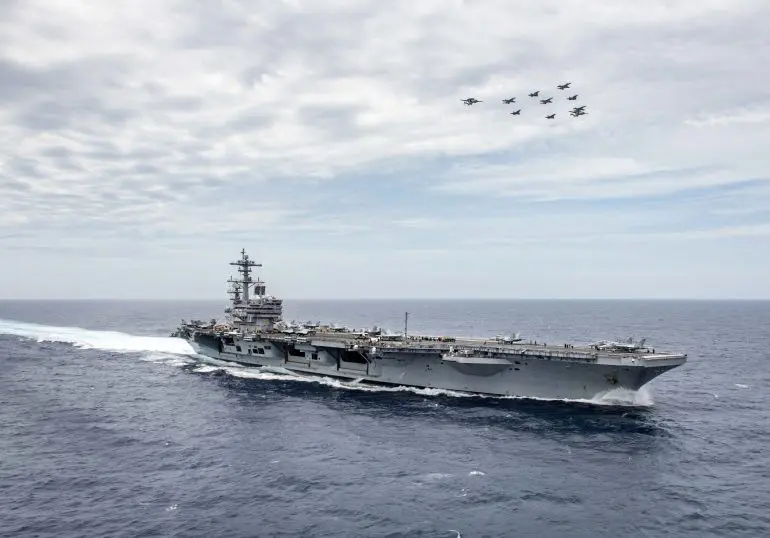In the early-nineteenth century, the Royal Navy launched kites from HMS Pallas to drop propaganda leaflets over Napoleon’s France. In the 1840s the Austrian Navy – albeit largely unsuccessfully – used the paddle steamer SMS Vulcano to launch incendiary balloons over Venice.
Later, wooden barges were used to launch hot-air balloons, mainly for aerial observation, and in 1911, the French ship Foudre stored seaplanes on deck and lowered them into the water for them to take off.
American aviator Eugene Ely was the first person to take off and launch from a stationary ship and the first aircraft carrier in the guise we know today – i.e to have a full-length flat deck – was HMS Argus in 1918.
Today, the world’s biggest aircraft carrier dwarfs the 172 metre Argus, but which one comes out on top? Here are the largest aircraft carriers in the world by length.
Cavour

The Italian navy's Cavour aircraft (Photo: Andreas Solaro via Getty Images)
Navy: Italy | Cost: €1.4 billion | Length: 244 metres | Displacement: 27,200 tons
The flagship of the Italian Navy, the Cavour – named after nineteenth century Prime Minister Camillo Benso, Count of Cavour – was commissioned in 2009 and combines fixed-wing and helicopter air operations. It has a top speed of 33 mph and the 8,024 square metre flight deck holds 10 F-35B Lightning II fighter planes and 12 Agusta Westland SW101 helicopters.
Charles de Gaulle

French aircraft carrier, Charles de Gaulle (Photo: Christophe Simon via Getty Images)
Navy: France | Cost: €3 billion | Length: 261.5 metres | Displacement: 42,500 tons
France’s first nuclear-powered surface ship, the Charles de Gaulle, named for France’s most famous statesman, has a top speed of 31 mph and is home to 1,950 crew and airmen. Just under half the weight of the heaviest aircraft carrier, the ship carries between 30 and 40 aircraft including the Dassault Rafale M fighter jet, the E-2C Hawkeye early warning plane, and an assortment of heavy-duty military helicopters.
HMS Queen Elizabeth

HMS Queen Elizabeth arrives in New York (Photo: Christopher Furlong via Getty Images)
Navy: UK | Length: 280 metres | Displacement: 65,000 tons | Cost: £3 billion
Commissioned in 2017, the Fleet Flagship of the Royal Navy is one of the fastest aircraft carriers in the world with a top speed of almost 37 mph. She has a range of 12,000 miles and instead of using the traditional bottle of Champagne to officially launch it, HM The Queen used a bottle of whisky! Based at HMNB Portsmouth, the ship carries F-35B Lightning combat aircraft and an array of troop transports and attack helicopters, including the world-famous Chinook, Apache AH MK1 and Wildcat AH1.
Admiral Kuznetsov

The Russian aircraft carrier Admiral Kuznetsov undergoes repairs (Photo: Lev Fedoseyev via Getty Images)
Navy: Russia | Length: 305 metres | Displacement: 58,600 tons | Range: 9,800 miles
Named after former Admiral of the Fleet of the Soviet Union Nikolay Gerasimovich Kuznetsov, the ship is a contender for longest aircraft carrier in the world. It has a top speed of 33 mph and carries a state-of-the-art surface-to-air missile system, P-700 cruise missiles and the UDAV-1 rocket launcher. One of the largest aircraft carriers in the world, the Admiral is home to 18 Sukhoi Su-33 and six MIG-29K jet fighters as well as six Kamov military helicopters.
Shandong

Aircraft carrier runway
Navy: China | Length: 315 metres | Displacement: 70,000 tons | Speed: 36 mph
In bronze medal spot for the title of world’s longest aircraft carrier, the Shandong is the first to be built entirely in China – their other carrier, the Liaoning, was built using a stripped-out Soviet aircraft cruiser. Commissioned in December 2019, the Shandong carries 44 aircraft consisting of 32 Shenyang J-15 twinjet fighter planes, eight Changhe Z-18 medium-lift transport helicopters and four Harbin Z-9 military utility helicopters.
USS George H. W. Bush

Aircraft flying in formation over the aircraft carrier USS George HW Bush (Photo: Smith Collection/Gado)
Navy: USA | Length: 333 metres | Displacement: 106,300 tons | Crew: 6,000+
The tenth and final Nimitz-class carrier of the US Navy, the $6.2 billion nuclear-powered warship was commissioned in 2009 and can operate for more than 20 years without the need for refuelling. The world’s heaviest aircraft carrier has a top speed of over 35 mph and carries around 90 helicopters and fixed-wing aircraft. Hull number CVN-77s callsign is Avenger, after the TBM Avenger torpedo bomber flown by the former president during World War II.
USS Gerald R Ford

USS Gerald R. Ford Begins Builder's Sea Trials (Photo
Navy: USA | Length: 337m | Displacement: 101,600 tons | Cost: $12.8 billion
Named after the 38th President of the United States and former Navy lieutenant commander, the nuclear-powered USS Gerald R Ford is the world’s biggest aircraft carrier, the largest warship ever built in terms of displacement and one of the biggest ships in the world. It is certainly the most expensive! Commissioned in July 2017, the 78m wide flight deck is capable of carrying up to 90 aircraft and is home to over 4,500 personnel.
From Balloons to Billions to Bust?
The largest aircraft carriers in the world are unfathomably complex feats of design, technology and construction, not to mention eye-wateringly expensive. Factor in the build and testing time and questions are being asked, albeit in hushed tones – is the future of the aircraft carrier in jeopardy? The lightning-fast advancements in faster-to-build unmanned and drone technology over the next 20 years will answer that question, but for now the aircraft carrier remains the dominant force across the world’s oceans.











